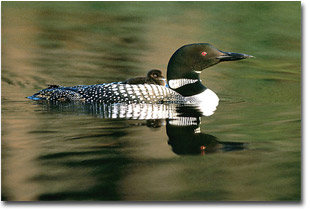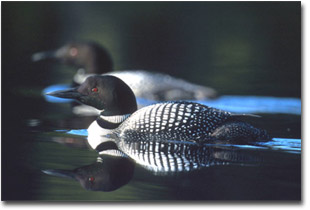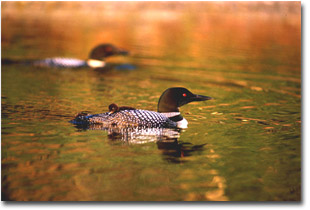“Who is this Gladys?” asked my wife one Fourth of July as we hosted some friends for a backyard barbecue. “She just called and said, tell Bill the chicks are ready!”
 When is a loon chick ready to meet the world? The one riding on its parent’s back in this picture was still in its an egg the night before posing for this photograph.
When is a loon chick ready to meet the world? The one riding on its parent’s back in this picture was still in its an egg the night before posing for this photograph.
How does one get so lucky to be there for such moments?
The equally entertaining pursuits of wildlife watching and wildlife photography encourage one to become a better naturalist. Knowing as much as one can about the species that you want to enjoy makes it easier to know not only when and where to find them, but also how to attempt viewing them so as not to interfere with their lives.
Building trust helps a lot too. Trust in this case involved the trust of not only the loon family, but also of the rangers at the pond where they spent their summers.
Loons typically mate for life and return to the same pond or lake, even to the same nest location, year after year. Experience of the past several years said that this pair would likely nest on a small island in the pond to hatch out a chick or chicks late in June or early in July. The rangers who monitored the pond agreed to call when they first saw an egg at the nest. With a known incubation period, it’s pretty easy to guess when to be around for the blessed event.
But being there for a sensitive moment in the life cycle of any animal also requires that one have respect for wildlife. Because I’d proven myself to these rangers by taking care with wildlife, most especially with the sensitive loons, they
 entrusted the information about where the nest was and when they’d first spotted the eggs that year.
entrusted the information about where the nest was and when they’d first spotted the eggs that year.
The trust of a loon is a bit more difficult to achieve. Some folks might attempt to paddle right over to the loon nursery area, usually a sheltered cove where they keep their chicks for the first several weeks. Not only might that prevent getting close enough for a good look at the loons, it can also cause them irreparable damage.
Ethical wildlife photographers avoid interfering with the lives of their subject. They use long telephoto lenses and either hide from their subjects or work with them for days to gain their acceptance.
I paddled just to the edge of the nursery area and stopped there to watch the loons going about their business. Using 600 millimeters of lens reach permitted photographing the loons at a distance for several hours for some decent pictures.
When did I move closer to get this picture? Never. Because I’d been respectful and shown them that no harm was meant, the loons eventually came over to visit.
I sat on the floor of the canoe to get the stability of a lower center of gravity, and set up a tripod with the legs barely extended. If do this and use a shutter speed of 1/250 of a second or faster, you should be able to keep camera movement to a minimum unless you're caught in a wind or current that turns the canoe too quickly.
Who knows? Perhaps they wanted to show off their new baby?
Taking Care With Loons
The common loon breeds in the northern tier of the United States, and in Canada, Greenland, Iceland and Scotland. The greatest numbers of North American common loons breed in Canada and Alaska. In the lower 48 states – after Minnesota – Maine and Wisconsin enjoy the most breeding loons, with several thousand each.
Loons arrive on their breeding lakes and ponds soon after ice-out. Males arrive first to claim their territory. Experienced pairs often nest where they did in prior years. Loons build their nests in late May and early June, unless high water from late spring rains or snow melt delays nesting. Since they have great difficulty walking on land, common loons nest right at the water's edge. Preference is given to islands and secluded marshy coves.
Loons tend their nests almost constantly during the 28-day incubation period, not only to keep the eggs warm, but also to protect them from predators. While both parents occasionally leave the nest unattended for a short time, any interference that drives them off of the nest for an hour or more places the eggs in great jeopardy.
 Avoid operating powered boats and other watercraft anywhere near a loon nest. Wave action can flood a nest and cool the eggs or could wash flotsam in front of the nest and make it difficult, perhaps impossible, for the parents to reach it. For a creature as natural as a loon is in the water, it has a minimal ability to move about when on land.
Avoid operating powered boats and other watercraft anywhere near a loon nest. Wave action can flood a nest and cool the eggs or could wash flotsam in front of the nest and make it difficult, perhaps impossible, for the parents to reach it. For a creature as natural as a loon is in the water, it has a minimal ability to move about when on land.
Once the chick has hatched, the parents take it to the water as soon as possible. Loons walk with great difficulty and therefore, feel much safer in the water.
The newly hatched chick rides on its parents most of its first week. After that, it rides a few hours a day for several weeks. Once too large to ride, it will swim along behind and wait patiently on the surface as its parents dive briefly after food.
Riding on an adult provides the new chick not only with warmth, but also with protection. Death can come quickly to a loon chick temporarily abandoned by its parents. A snapping turtle might gobble it up from below. An eagle, or more commonly, a gull might strike from above.
Loon parents generally stay in shallow and sheltered waters with minimal wave activity during the first several weeks of the chick's life. They also stay close to shore, perhaps to send their chicks to hide along the edge should danger threaten.
To learn more about how to photograph loons without interfering, look for the just released second edition of my book with author Alan Hutchinson, Just Loons. The new release includes a CD of loon calls so that you can better understand what they’re saying. Also visit the new loon page on my website at www.camerahunter.com/just_loons.html.
Catch yours in the good light.
BS-NPN 012
http://camerahunter.com
Comments on Bill Silliker, Jr.'s The Camera Hunter articles? Send them to the editor.
Maine wildlife & nature photographer Bill Silliker, Jr. – The Mooseman - photographed at many wild places in North America, with the results published in magazines internationally and in 9 of his own books. Bill was an instructor of wildlife and nature photography for L. L. Bean's Outdoor Discovery Program and a member of the Fuji Film Talent Team. Read more about Bill on the Camera Hunter archives page.



